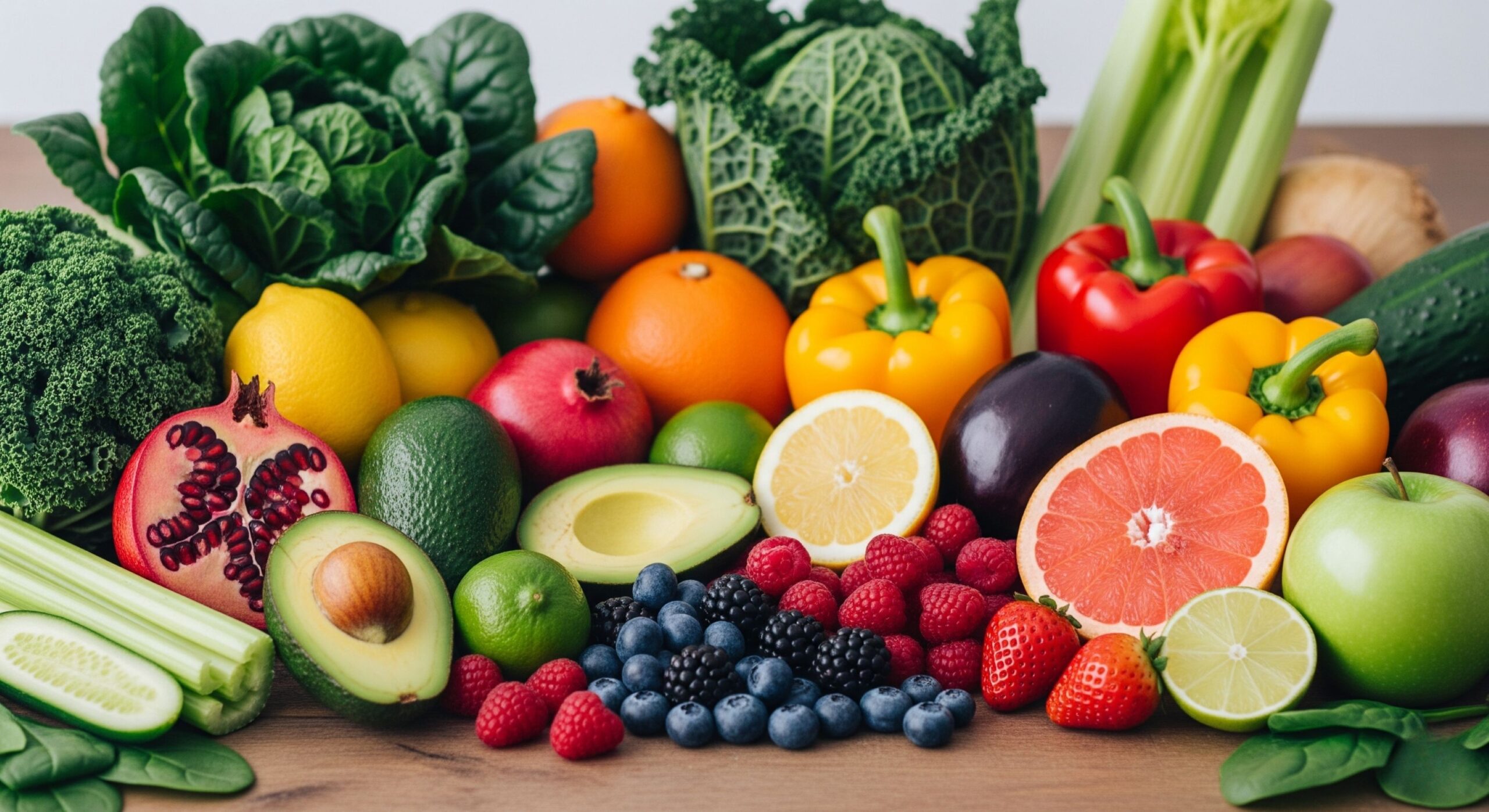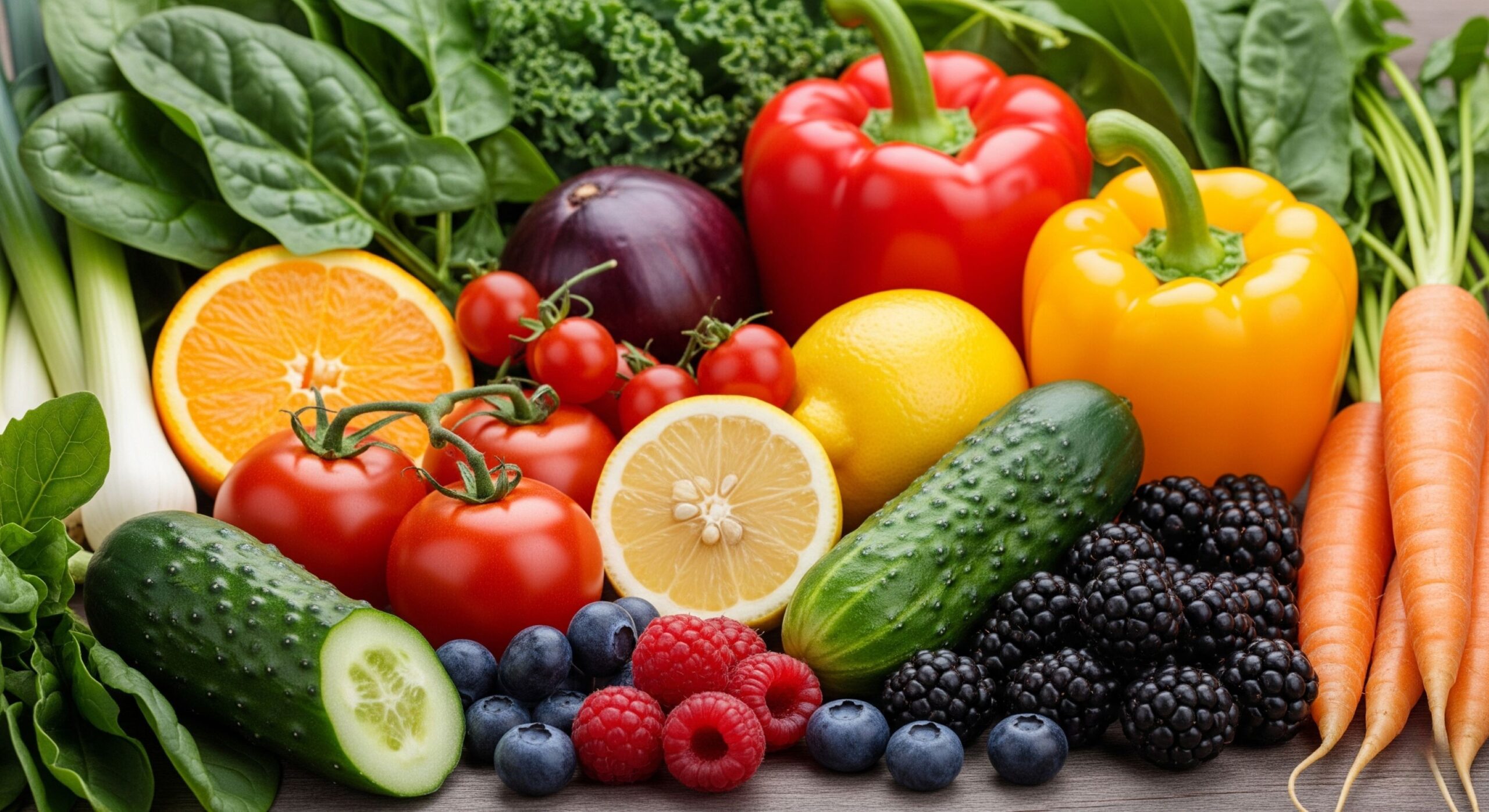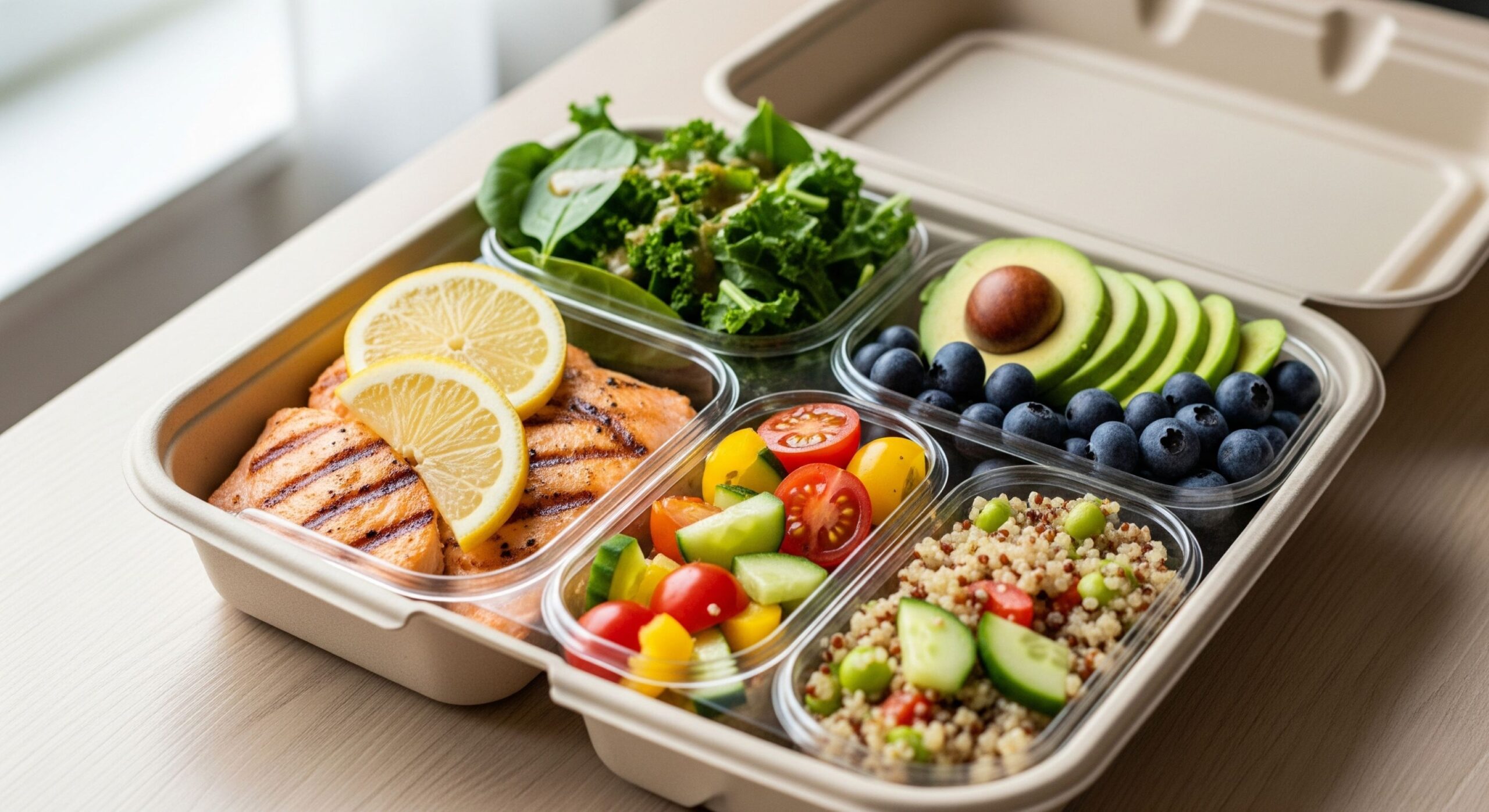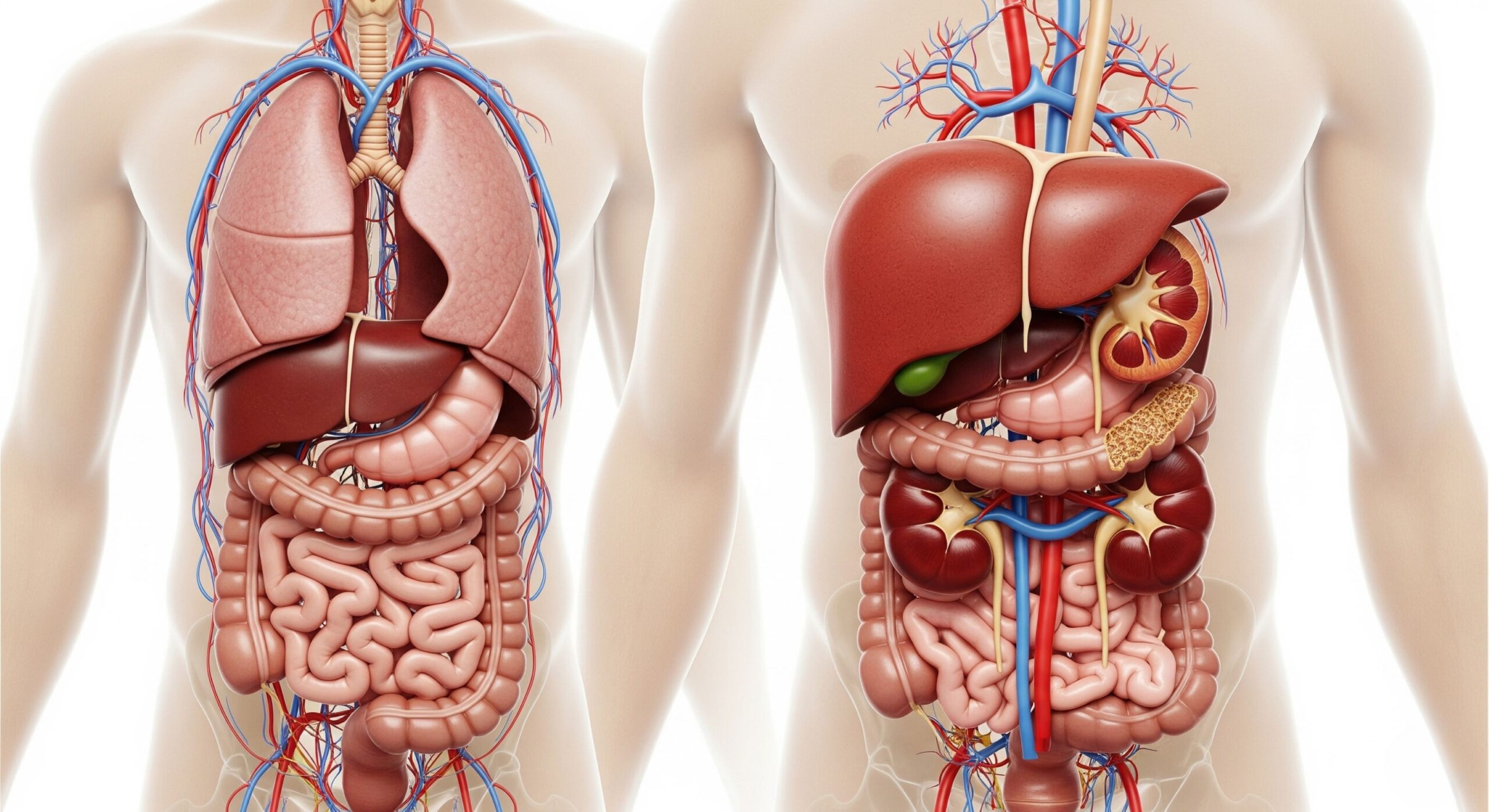
Ready to feel refreshed and energized without resorting to extreme measures? A science-backed detox plan isn’t about deprivation; it’s about supporting your body’s brilliant, built-in cleansing systems. This guide will walk you through how your body naturally detoxifies, provide a nourishing 7-day meal plan, and share simple lifestyle habits to help you thrive. Let’s cut through the hype and focus on what truly works.
How a Natural Cleansing Plan Supports Your Body
To follow a science-backed detox plan, it helps to first understand how your body already works. Before you even think about starting a new diet, take a moment to appreciate your body’s amazing, built-in cleansing crew. It’s not just one organ doing all the work—it’s a whole team working together. Understanding their roles is key because it shows you exactly which systems you need to support.

Your body’s detoxification system is a team of organs working together, led by the liver.
How a Science-Backed Detox Plan Supports the Liver
Think of your liver as the main command center for detoxification. It works around the clock, filtering your blood and neutralizing harmful substances. Its clever two-step process shows why certain foods are so powerful for a cleanse:
- Phase I Detoxification: This is your first line of defense. Here, special enzymes start to process toxins stored in your fat cells. This process needs plenty of B vitamins and, importantly, it creates unstable molecules called free radicals. For this reason, a diet packed with antioxidants is crucial to protect your body.
- Phase II Detoxification: In this next step, the body makes those activated toxins water-soluble. This process neutralizes them, making them easy for your body to get rid of. This phase relies on amino acids and sulfur, which is why foods like garlic, onions, and eggs are so helpful in a science-backed detox plan.
The Detox Support Team: Other Key Organs in Your Cleanse
Of course, the liver doesn’t work alone. An effective detox plan also supports all of the body’s pathways for removing waste. So, let’s meet the rest of the team:
- The Kidneys: Your kidneys are your body’s master filters. They constantly clean your blood, removing waste and extra water to make urine. Therefore, the single best thing you can do for them is stay well-hydrated.
- The Gut and Intestines: Your gut is a critical barrier against toxins. A healthy gut lining prevents harmful substances from entering your bloodstream. In this case, fiber is your best friend—it binds to waste and helps carry it out of the body.
- The Skin: As your largest organ, your skin offers another way to remove waste through sweat. That’s why sweating during exercise or in a sauna can help your body release small amounts of toxins.
- The Lungs: Your lungs do more than just breathe in oxygen; they also exhale gaseous waste products. Practicing deep breathing can make this process even more efficient.
- The Lymphatic System: Think of this system as the body’s drainage network. It collects waste from your cells, but it relies on you moving your body to keep the fluid flowing.
Recognizing When Your Body Needs a Natural Cleanse
Your body has subtle ways of telling you when its detox systems are overworked. Common signs your body needs support include feeling tired all the time, digestive troubles, frequent headaches, or brain fog. These signals often mean your body could use a little extra support from a thoughtful detox plan.
Core Methods of a Science-Backed Detox Plan
A successful science-backed detox plan isn’t just about food. It combines a nutrient-rich diet with lifestyle habits that help your body’s natural cleansing process. In other words, you don’t need expensive kits or fancy potions—just simple, powerful tools to support your health.
Diet Principles for Your Science-Backed Detox Plan
A smart cleansing diet is about adding more nutrients, not just cutting calories. The main goal is to give your body plenty of vitamins and minerals while reducing the burden of processed foods. This simply means building your meals around whole, unprocessed foods like fresh fruits and vegetables, lean proteins, and healthy fats.

A vibrant array of fresh fruits and vegetables forms the foundation of any effective detox plan.
Power Foods for a Science-Backed Cleanse
In addition, adding certain foods to your detox plan can give your body’s cleansing power a major boost. For example, here are some of the best foods to focus on:
- Cruciferous Vegetables: This group includes broccoli, cauliflower, and kale. They’re loaded with a compound that helps the liver’s Phase II detox enzymes do their job.
- Sulfur-Rich Foods: Garlic, onions, and eggs are great sources of sulfur, which is a key building block for one of the body’s most powerful antioxidants, glutathione.
- Antioxidant Powerhouses: Berries, leafy greens, and green tea are full of antioxidants that protect your cells from the damage caused by free radicals.
- High-Fiber Options: Foods packed with fiber, like apples and oats, help trap toxins in the digestive system and carry them out.
- Herbs and Spices: Turmeric contains curcumin, a powerful anti-inflammatory. Cilantro is thought to help remove heavy metals, while parsley helps the kidneys flush out waste.
- Beets: These colorful root vegetables contain compounds that support Phase II detox and offer strong antioxidant benefits.
Hydration Strategies for Your Cleansing Plan
Staying hydrated is non-negotiable for any detox. Water is absolutely essential for helping your kidneys flush out waste. For this reason, you should aim for about 8-10 glasses of filtered water each day. On top of that, herbal teas like dandelion root, milk thistle, and ginger can give your cleanse an extra supportive boost.
Your 7-Day Science-Backed Detox Plan Menu
This science-backed detox plan offers a clear yet flexible way to support your body’s natural cleansing process. Most importantly, it’s gentle, nourishing, and focused on building healthy habits that you can maintain long-term.
Preparing for Your Detox Plan
Success starts with a little preparation. For instance, a few days before you begin, go grocery shopping for all the fresh, whole foods you’ll need. It’s also a great idea to slowly cut back on caffeine, sugar, and processed foods beforehand. This will make the transition much smoother for your body.

Prepping meals with whole ingredients makes sticking to your detox plan simple and delicious.
Phase 1: Reset (Days 1-2)
To start, this first phase removes common inflammatory foods from your diet. It focuses on great hydration and simple, easy-to-digest meals. This gentle start helps your body adjust without the shock of a more extreme diet.
- Day 1 Menu:
- Breakfast: Oatmeal with fresh berries and a sprinkle of cinnamon.
- Lunch: Large salad with mixed greens, cucumber, bell peppers, carrots, and a lemon-tahini dressing.
- Dinner: Steamed broccoli with a baked sweet potato and a side of brown rice.
- Snacks: An apple with almond butter; a handful of walnuts.
- Day 2 Menu:
- Breakfast: Green smoothie with spinach, banana, pineapple, and unsweetened almond milk.
- Lunch: Leftover salad from Day 1.
- Dinner: Hearty vegetable soup made with a variety of colorful veggies.
- Snacks: A pear; celery sticks with hummus.
Phase 2: Recharge (Days 3-5)
Next, you’ll start adding lean proteins and healthy fats to the clean base you’ve built. This step ensures your body has the key amino acids it needs for liver detox while giving you sustained energy.
- Day 3 Menu:
- Breakfast: Scrambled eggs (or a tofu scramble) with spinach and avocado.
- Lunch: Quinoa bowl with roasted chickpeas, cucumber, and tomatoes.
- Dinner: Baked salmon with roasted asparagus and a side of quinoa.
- Snacks: A handful of almonds; unsweetened Greek yogurt.
- Day 4 Menu:
- Breakfast: Another green smoothie to start the day right.
- Lunch: Leftover quinoa bowl from Day 3.
- Dinner: Grilled chicken breast with steamed green beans and roasted carrots.
- Snacks: An orange; a small bowl of fresh berries.
- Day 5 Menu:
- Breakfast: Oatmeal with sliced peaches and chia seeds.
- Lunch: Lentil soup with a side salad.
- Dinner: Turkey meatballs served with zucchini noodles and a simple tomato sauce.
- Snacks: A hard-boiled egg; rice cakes with avocado.
Phase 3: Restore (Days 6-7)
Finally, this last phase gently broadens your food choices while reinforcing the healthy habits you’ve started. The goal here is to create a smooth transition back into a sustainable, long-term healthy eating pattern.
- Day 6 Menu:
- Breakfast: Greek yogurt with berries and a sprinkle of flax seeds.
- Lunch: Leftover turkey meatballs and zucchini noodles.
- Dinner: A colorful veggie stir-fry with tofu or shrimp, served with brown rice.
- Snacks: A banana; a handful of pumpkin seeds.
- Day 7 Menu:
- Breakfast: Scrambled eggs with sautéed mushrooms and onions.
- Lunch: A large salad topped with grilled chicken strips.
- Dinner: Black bean burgers (patties only) served with a large side salad.
- Snacks: An apple with a cheese stick; carrots with hummus.
After the Detox
Once your 7-day plan is complete, try not to slip right back into old habits. After all, the real goal is lasting change. A great way to do this is to add other foods back into your diet slowly, paying close attention to how your body feels. This is a perfect opportunity to learn what truly makes you feel your best.
Beverages and Recipes for Your Science-Backed Detox Plan
What you drink during a detox is just as important as what you eat. In fact, the right beverages do more than just hydrate you—they can actively support your body’s cleansing process. Here are a few simple recipes to include in your plan.

Hydration is key; detox-friendly beverages support your body’s cleansing process.
Simple Green Detox Smoothie
This nutrient-packed smoothie is perfect for breakfast or a healthy afternoon snack.
- 1 cup spinach
- 1/2 cup pineapple (frozen works well)
- 1/2 green apple
- 1/2 inch piece of fresh ginger
- 1 tablespoon chia seeds
- 1 cup unsweetened almond milk or water
- Just blend all ingredients until smooth and enjoy!
Liver-Loving Lemon Ginger Tea
Start your morning with this simple tea to gently wake up your digestive system and support your liver.
- 1 cup warm water
- Juice of 1/2 lemon
- 3-4 thin slices of fresh ginger
- To prepare, steep the ginger in warm water for 5 minutes, then stir in the lemon juice.
Refreshing Cucumber Mint Infused Water
This delicious infused water makes it easy and enjoyable to stay hydrated all day long.
- 1 pitcher of filtered water
- 1/2 cucumber, thinly sliced
- A handful of fresh mint leaves
- Simply combine the ingredients and chill them in the fridge for at least one hour to let the flavors infuse.
Lifestyle Habits for Your Science-Backed Detox Plan
A truly effective detox plan doesn’t stop with your diet. It’s a holistic approach that includes lifestyle habits to fully support your body’s natural cleansing abilities. As it turns out, your daily activities can be just as important as the food you eat.
Movement in Your Science-Backed Detox Plan
Regular exercise is a powerful detox tool. For example, it improves your circulation, helps your body release toxins through sweat, and gets your lymph fluid moving—which is essential for waste removal.

Gentle movements like yoga support lymphatic drainage and aid the detoxification process.
Sweat-Based Detox Methods:
- Cardiovascular exercise: Activities like brisk walking, jogging, or cycling get your heart rate up and promote healthy sweating.
- Sauna sessions: Spending time in a sauna is another great way to encourage sweating, which can help draw out toxins.
- Yoga: Additionally, many yoga poses, especially twists, are thought to gently stimulate your digestive organs and support cleansing.
Lymphatic Support Techniques:
Because the lymphatic system doesn’t have its own pump, it relies on your movement to keep things flowing. This is why detox plans often include activities like rebounding (jumping on a mini-trampoline), dry brushing the skin, and yoga to stimulate circulation.
Stress Management in a Science-Backed Cleanse
Here’s something you might not know: chronic stress can seriously hinder your body’s ability to detox. It raises stress hormones like cortisol, which can slow down your liver function. Therefore, managing stress is a crucial part of any successful science-backed detox plan.
Chronic stress puts a strain on your body’s detoxification system. High levels of cortisol over time can deplete your body of the nutrients and energy needed for Phase II detoxification. This leaves your system more vulnerable to toxic buildup.
Stress-Reduction Strategies:
- Mindfulness meditation: Even just 5-10 minutes of quiet meditation each day can help lower stress hormones.
- Journaling: Writing down your thoughts is a powerful way to process feelings and release mental clutter.
- Deep Breathing: Whenever you feel stressed, take a few slow, deep breaths to instantly calm your nervous system.
Sleep Quality and Natural Detox
On top of everything else, quality sleep is absolutely vital for detoxification. While you sleep, your brain goes through a remarkable self-cleaning process. In fact, research from the NIH shows this “rinse cycle” is highly active during deep sleep. Poor sleep gets in the way of this key function, making 7-9 hours of restful sleep a core part of any effective detox plan.
Environmental and Digital Aspects of Your Detox Plan
A truly comprehensive detox also looks at the toxins in your environment and the mental clutter from too much screen time. Reducing your exposure in both of these areas can make a huge difference in how you feel.
Reducing Environmental Toxin Exposure
Indeed, creating a cleaner home environment is a simple yet powerful way to support your detox efforts. You can start with just a few easy changes:
Household Detox Strategies:
- Swap harsh chemical cleaners for natural options like vinegar and baking soda.
- Choose personal care products with simple, recognizable ingredients.
- Use houseplants or an air purifier to improve your indoor air quality.
- Filter your drinking water to remove common contaminants like chlorine.
- Switch from plastic food containers to glass or stainless steel to avoid chemical leaching.
Digital Wellness in Your Detox Plan
In the same way, mental clarity is a huge part of feeling refreshed. Constant screen time leads to mental fatigue and can disrupt your sleep, which in turn gets in the way of your body’s nightly repair process. A “digital detox” can help you feel more focused and calm.
Digital Detox Strategies:
- Create tech-free zones, such as making the bedroom a phone-free area.
- Schedule regular breaks from your devices throughout the day to stand up, stretch, and rest your eyes.
- Practice a “digital sunset” by turning off all screens at least one hour before you plan to go to bed.
Maintaining Your Science-Backed Detox Plan Results
A science-backed detox plan shouldn’t be a temporary fix. Think of it as a foundation for a healthier lifestyle. Once you’re feeling great, the key is to keep that momentum going. So, here are a few practical tips to help you succeed long-term:
- Embrace the 80/20 Rule: First of all, perfection isn’t the goal. Aim to eat healthy, whole foods 80% of the time, and allow yourself the flexibility for treats the other 20%. This balanced approach prevents burnout and makes a healthy lifestyle sustainable.
- Practice Mindful Eating: Pay attention to your food, savor each bite, and listen to your body’s natural hunger and fullness cues. This helps you build a healthier relationship with food and avoid overeating.
- Listen to Your Body: After a detox, you’ll be more in tune with how your body responds to different foods. Notice which foods give you energy and which make you feel sluggish. Use this feedback to make smarter choices every day.
- Make Hydration a Habit: Finally, keep a reusable water bottle with you during the day as a constant reminder. Starting your morning with a glass of lemon water is also a great habit for supporting your digestive system.
Safety Guidelines for a Science-Backed Detox Plan
While a science-backed detox plan that uses whole foods is safe for most people, it’s not the right fit for everyone. Because of this, it’s always important to listen to your body and talk to a healthcare professional if you have any concerns.
Who Should Avoid Restrictive Detox Plans
- Pregnant and nursing women: They require consistent, nutrient-dense calories for their own health and their baby’s development.
- Individuals with chronic conditions: Anyone with a condition like diabetes or kidney disease should talk to their doctor before making significant diet changes.
- Those with a history of eating disorders: Likewise, restrictive diets can be a trigger and should generally be avoided.
- Children and adolescents: They need steady nutrition to support proper growth and development.
Managing Detox Transition Symptoms
As your body adjusts to a cleaner way of eating, it’s not uncommon to feel some temporary side effects. In most cases, this is a normal part of the process, but it’s good to know what you might expect.
Common Adjustment Symptoms:
- Mild headaches: These are often a result of cutting back on caffeine or sugar. Be sure to drink plenty of water to stay hydrated.
- Temporary fatigue: Your body is getting used to a new fuel source. Allow yourself extra time to rest.
- Digestive changes: An increase in fiber can sometimes cause temporary bloating or changes in bowel habits.
- Mood fluctuations: Changes in your diet can sometimes affect your mood. Be patient and gentle with yourself during the transition.
These symptoms usually go away within 3-5 days. However, if they don’t improve or if they get worse, you should stop the program and consult a doctor. Above all, a good detox plan should ultimately make you feel better, not worse.
Science-Backed Detox Plan: FAQs
What is the best science-backed detox plan for beginners?
The best science-backed detox plan for beginners is one that starts with gentle diet changes, not harsh rules. First, focus on cutting out processed foods, drinking more water, and adding more vegetables to every meal. A simple 7-day plan like the one in this guide is a great way to build a foundation for long-term health.
How often should I do a body detox cleanse?
Because your body detoxes 24/7, you don’t need to do intense cleanses often. Instead, think of a gentle, food-based cleanse as something you could do with the seasons (about four times a year) or whenever you feel your system needs a reset. Your daily habits, like staying hydrated and eating whole foods, provide the most consistent support.
What foods should I include in a cleansing diet?
For the best results, focus on cruciferous vegetables like broccoli, sulfur-rich foods like garlic, antioxidant-packed fruits like berries, and high-fiber foods like oats. These foods give your liver the key nutrients it needs for its two-phase detoxification process.
Can a detox plan help with weight management?
While weight loss isn’t the primary goal, many people do lose a few pounds during a detox. This is usually a positive side effect of cutting out processed foods and adopting healthier eating habits. For more focused weight management, it’s helpful to combine your cleanse with a science-backed plan for long-term results.
Sources & References
The information in this guide is based on established research and guidelines from leading health organizations. For further reading and detailed information, please consult the following resources:
- Harvard Medical School. “The Dubious Practice of Detox.”
- National Institutes of Health (NIH). “Brain May Flush Out Toxins During Sleep.”
- Cleveland Clinic. “Liver Function Tests.”
- Sears, Margaret E., et al. “Arsenic, Cadmium, Lead, and Mercury in Sweat: A Systematic Review.” Journal of Environmental and Public Health, 2012.
- American Psychological Association. “Stress Effects on the Body.”
- Centers for Disease control and Prevention. “Healthy Eating for a Healthy Weight.”
Your Guide to a Natural Detox
The Body’s Detox Team
Click on an organ to reveal its cleansing role.
- The LiverThe master detoxifier. Filters blood and neutralizes toxins in a two-phase process.
- The KidneysFilters waste from the blood to produce urine. Hydration is key to support them.
- The GutA critical barrier. Fiber helps bind to and remove toxins from the digestive tract.
- The SkinThe body’s largest organ. Eliminates some toxins through sweat.
- The LungsExhale gaseous waste products like carbon dioxide. Deep breathing helps.
Power Foods for Cleansing
- Cruciferous Veggies(Broccoli, Kale) Support and activate crucial liver enzymes for detoxification.
- Sulfur-Rich Foods(Garlic, Onions) Help the body produce glutathione, its master antioxidant.
- Antioxidants(Berries, Greens) Neutralize harmful free radicals produced during detox.
- High-Fiber Options(Oats, Beans) Bind to toxins in the gut and ensure their elimination.
- Herbs & Spices(Turmeric, Cilantro) Provide anti-inflammatory and cleansing support.
Supportive Lifestyle Habits
- Move & SweatExercise boosts circulation, promotes sweating, and stimulates lymphatic flow.
- Manage StressChronic stress impairs liver function. Practice meditation and deep breathing.
- Prioritize SleepAim for 7-9 hours. The brain’s unique glymphatic system cleanses itself during sleep.
- Stay HydratedWater is essential for kidney function and flushing out water-soluble toxins.
